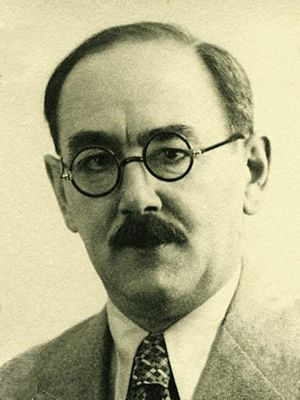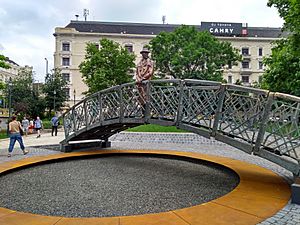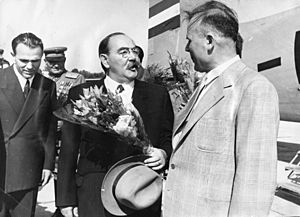Imre Nagy facts for kids
Quick facts for kids
Imre Nagy
|
|||||||||||||||||||
|---|---|---|---|---|---|---|---|---|---|---|---|---|---|---|---|---|---|---|---|

Nagy in 1945
|
|||||||||||||||||||
| Chairman of the Council of Ministers of the Hungarian People's Republic | |||||||||||||||||||
| In office 24 October 1956 – 4 November 1956 |
|||||||||||||||||||
| Deputy |
List
Antal Apró Ferenc Erdei József Bognár (27 Oct. 1956–) András Hegedüs (–27 Oct. 1956) István Hidas (–27 Oct. 1956) György Marosán (–27 Oct. 1956) József Mekis (–27 Oct. 1956) |
||||||||||||||||||
| First Secretary | Ernő Gerő János Kádár |
||||||||||||||||||
| Preceded by | András Hegedűs | ||||||||||||||||||
| Succeeded by | János Kádár | ||||||||||||||||||
| In office 4 July 1953 – 18 April 1955 |
|||||||||||||||||||
| Deputy |
List
|
||||||||||||||||||
| First Secretary | Mátyás Rákosi | ||||||||||||||||||
| Preceded by | Mátyás Rákosi | ||||||||||||||||||
| Succeeded by | András Hegedűs | ||||||||||||||||||
| Minister of Foreign Affairs | |||||||||||||||||||
| In office 2 November 1956 – 4 November 1956 |
|||||||||||||||||||
| Preceded by | Imre Horváth | ||||||||||||||||||
| Succeeded by | Imre Horváth | ||||||||||||||||||
| Speaker of the National Assembly | |||||||||||||||||||
| In office 16 September 1947 – 8 June 1949 |
|||||||||||||||||||
| Preceded by | Árpád Szabó | ||||||||||||||||||
| Succeeded by | Károly Olt | ||||||||||||||||||
| Minister of the Interior | |||||||||||||||||||
| In office 15 November 1945 – 20 March 1946 |
|||||||||||||||||||
| Prime Minister | Zoltán Tildy Ferenc Nagy |
||||||||||||||||||
| Preceded by | Ferenc Erdei | ||||||||||||||||||
| Succeeded by | László Rajk | ||||||||||||||||||
| Minister of Agriculture | |||||||||||||||||||
| In office 22 December 1944 – 15 November 1945 |
|||||||||||||||||||
| Prime Minister | Béla Miklós | ||||||||||||||||||
| Preceded by | Fidél Pálffy | ||||||||||||||||||
| Succeeded by | Béla Kovács | ||||||||||||||||||
|
|||||||||||||||||||
| Personal details | |||||||||||||||||||
| Born | 7 June 1896 Kaposvár, Somogy County, Kingdom of Hungary, Austria-Hungary |
||||||||||||||||||
| Died | 16 June 1958 (aged 62) Budapest, Hungarian People's Republic |
||||||||||||||||||
| Cause of death | Execution by hanging | ||||||||||||||||||
| Nationality | Hungarian | ||||||||||||||||||
| Political party | Communist Party of the Soviet Union Social Democratic Party of Hungary Hungarian Communist Party, Hungarian Working People's Party, Hungarian Socialist Workers' Party |
||||||||||||||||||
| Spouse |
Mária Égető (1902–1978)
(m. 1925) |
||||||||||||||||||
| Children | Erzsébet | ||||||||||||||||||
| Military service | |||||||||||||||||||
| Allegiance | |||||||||||||||||||
| Branch/service | Austro-Hungarian Army (Royal Hungarian Honvéd) (1914–1916) Red Army (1918) |
||||||||||||||||||
| Years of service | 1914–1916 1918 |
||||||||||||||||||
| Rank | Corporal | ||||||||||||||||||
| Unit | 17th Royal Hungarian Honvéd Infantry Regiment (1915) 19th Machine Gun Battalion (1916) |
||||||||||||||||||
| Battles/wars | World War I
|
||||||||||||||||||
Imre Nagy (born June 7, 1896 – died June 16, 1958) was an important Hungarian politician. He served as the Prime Minister of Hungary from 1953 to 1955. He became a key leader during the Hungarian Revolution of 1956. This was a major uprising against the Soviet-backed government. Because of his role, he was later sentenced to death and executed.
Nagy became a communist after the Russian Revolution. He worked secretly for the party in Hungary during the 1920s. He lived in the Soviet Union for many years. He returned to Hungary before World War II ended. He then held various government jobs as the Hungarian Working People's Party took control. Hungary became part of the Soviet Union's area of influence. He was the Interior Minister from 1945 to 1946.
In 1953, Nagy became Prime Minister. He tried to make the government less strict, moving away from the harsh rules of Mátyás Rákosi. But Rákosi still had a lot of power. Nagy was forced out of the government in 1955. Even so, many people, especially writers and thinkers, still liked him. They saw him as a symbol of change against the strict government.
The Hungarian Revolution began on October 23, 1956. People demanded that Nagy become Prime Minister again. He was given the role on October 24. Nagy's group took full control of the government. They included politicians who were not communists. They also got rid of the secret police. Nagy promised democratic changes and said Hungary would leave the Warsaw Pact. This was a military alliance led by the Soviet Union.
On November 4, the Soviet Union sent a large army into Hungary. They removed Nagy from power. He found safety in the Yugoslav Embassy in Budapest. On November 22, he was tricked into leaving the embassy. He was arrested and sent to Romania. On June 16, 1958, Nagy was put on trial and executed for treason. His body was buried in a secret, unmarked grave.
In June 1989, Nagy and other leaders of the 1956 Revolution were honored again. Their bodies were reburied with full ceremonies. This event was very important in ending communist rule in Hungary.
Contents
Early Life and World War I Experience
Imre Nagy was born on June 7, 1896, in Kaposvár, Hungary. His family was from the countryside. His father worked as a carriage driver and later as a postal worker. His mother was a maid.
Nagy went to school in Kaposvár. He did not do well at first. He then became a locksmith and later worked in a factory. In 1914, he became a clerk in a lawyer's office. He also attended a commercial high school.
When World War I started in 1914, Nagy joined the Austro-Hungarian Army. He was sent to the Italian Front in 1915. He was wounded in the leg. After recovering, he became a machine gunner. In 1916, he was sent to the Eastern Front. He was wounded again and captured by the Russian army. He was taken to Siberia as a prisoner of war.
Starting a Political Career
While a prisoner in Siberia, Imre Nagy joined a group that discussed Marxism. In 1918, he joined the Communist Party. He fought with the Red Army during the Russian Civil War. Some stories say he might have guarded the Russian royal family.
After the Civil War, Nagy became a full member of the Russian Communist Party. He worked for the communist secret police, dealing with prisoners of war. In 1921, he returned to Hungary. The Communist Party was banned there. He joined the Social Democratic Party of Hungary. He worked to build up the socialist movement in his hometown.
In 1926, Nagy helped start the Kaposvár office of the Socialist Workers’ Party of Hungary. This was a left-wing group. He was successful in getting support for the party. He was arrested in 1927 and later went to Vienna. He worked for the Communist Party there. He tried to build secret communist groups in Hungary, but it was difficult.
Years in Moscow and Government Roles
In 1929, Imre Nagy moved to the Soviet Union. He became a Soviet citizen. He worked on agricultural research and for the Comintern, an international communist organization. During this time, he also worked for the Soviet secret police as an informer. This service helped him gain support from Soviet leaders later on.
After World War II, Nagy returned to Hungary. He became the Minister of Agriculture. He helped divide land among farmers. In the next government, he was the Minister of Interior. He was involved in the removal of Hungarian Germans from the country.
He held other important roles in the communist government. He was also the Speaker of the National Assembly from 1947 to 1949. In 1951, he signed an order that led to the arrest of János Kádár. Kádár was later sentenced to prison.
Nagy became Prime Minister in 1953. He tried to introduce a "New Course" to make socialism less harsh. But he lost favor with the Soviet leaders. He was removed from his party roles and from his position as Prime Minister in 1955.
The 1956 Revolution
After Nikita Khrushchev spoke out against the crimes of Joseph Stalin in 1956, people in Eastern Europe wanted more freedom. In Hungary, the leader Mátyás Rákosi was criticized a lot. People wanted him to resign. Many people wanted Imre Nagy to return to power.
The Soviets forced Rákosi to resign in July 1956. But they replaced him with Ernő Gerő, who was also very strict. This did not make people happy. Nagy was readmitted to the Communist Party in October. On October 22, students in Budapest made a list of demands. One of them was for Nagy to become Prime Minister again.
On October 23, a large protest took place in Budapest. People chanted slogans supporting Imre Nagy. Nagy was unsure about supporting the protest at first. He wanted changes to happen within the system, not through a revolution. But his friends convinced him to speak to the protesters. His speech did not calm the crowd. The protests soon turned into a full revolt. The secret police opened fire on the protesters. Hungarian soldiers joined the people. Gerő then asked the Soviet Union for help.
Early on October 24, Nagy was made Prime Minister again. This was an attempt to calm the people. But he was isolated in the government. He could not stop the Soviet invasion of Budapest that day. Many people thought Nagy had asked for Soviet help, which hurt their trust in him. He declared martial law and offered forgiveness to rebels who gave up their weapons.
On October 27, Nagy announced a new government. It included politicians who were not communists. He met with Soviet representatives to ask for a ceasefire and a political solution.
On October 28, Nagy stopped a large attack by Soviet troops on rebel strongholds. He negotiated a ceasefire. He then gave a radio speech, calling the events a "national democratic movement." He supported the Revolution and promised to meet the people's demands. He announced that the secret police would be dissolved. He also said he would negotiate for Soviet troops to leave Budapest. Nagy also supported creating a National Guard to keep order.
By October 30, Nagy's reform group had full control of the Hungarian government. The strict communist leaders had left for the Soviet Union. Nagy's government announced it would bring back a multi-party system. Nagy believed in a changing form of Marxism. He wanted a limited multi-party system within a socialist framework.
On October 31, Nagy was appointed to the leadership of the new Hungarian Socialist Workers' Party. This party was meant to keep the Revolution's gains. However, the Soviet leaders decided the Revolution had gone too far. Soviet troops began to re-enter Hungary. Nagy protested this to the Soviet Ambassador. The Ambassador said the troops were only there to cover a withdrawal. This led Nagy to make a big decision. He announced that Hungary would leave the Warsaw Pact. He asked the United Nations to recognize Hungary as a neutral country.
Between November 1 and 3, Soviet leader Nikita Khrushchev visited other countries. He told them about his plans to attack Hungary. On November 3, Nagy formed a new government. It included members from different parties. But this government would only last for less than a day.
In the early morning of November 4, the Soviet Union launched a massive military attack on Hungary. Nagy announced this to the country and the world. He ordered the Hungarian Army not to fight back to prevent more damage. He then fled to the Yugoslav Embassy for safety.
Despite a promise of safe passage, Nagy was arrested by Soviet forces on November 22. He was taken to Romania.
Secret Trial and Execution

Later, the Soviets brought Imre Nagy back to Hungary. He was secretly accused of trying to overthrow the Hungarian government and of treason. He was tried in secret, found guilty, and sentenced to death. He was executed in June 1958. His trial and execution were only announced to the public after they had happened.
Nagy was buried in the prison yard. Years later, his body was moved to a distant corner of the New Public Cemetery, Budapest. He was buried face-down, with his hands and feet tied. A memorial bell stands near his grave. It has a Latin saying that means: "I call the living, I mourn the dead, I break the thunderbolts."
Memorials and Political Rehabilitation
For many years, the communist government in Hungary did not allow Nagy's death to be remembered. People could not visit his burial place. A memorial was put up for him in Paris in 1988.
In 1989, Imre Nagy was officially cleared of his charges. His remains were reburied on the 31st anniversary of his execution. This funeral was organized by those who opposed the communist government. More than 200,000 people attended. Nagy's funeral was a very important event in the end of communist rule in Hungary.
On December 28, 2018, a popular statue of Nagy in central Budapest was moved. It was placed in a less central spot. This was done to rebuild a memorial to the victims of the 1919 Red Terror. Some people saw this as an attempt to change history. Others said it was to restore the city to its look before World War Two.
Family Life
Imre Nagy was married to Mária Égető. They had one daughter, Erzsébet Nagy, who became a writer and translator. Imre Nagy supported his daughter's marriage to a Protestant minister. He even attended their religious wedding ceremony in 1946.
Nagy in Film and Arts
- In 2003 and 2004, Hungarian director Márta Mészáros made a film about Nagy's life after the revolution. It was called A temetetlen halott (English: The Unburied Body).
- Nagy is also mentioned and seen in the 2006 movie Children of Glory.
See also
 In Spanish: Imre Nagy para niños
In Spanish: Imre Nagy para niños
- Hungarian Revolution of 1956
- Governments of Imre Nagy
- End of Communism in Hungary


